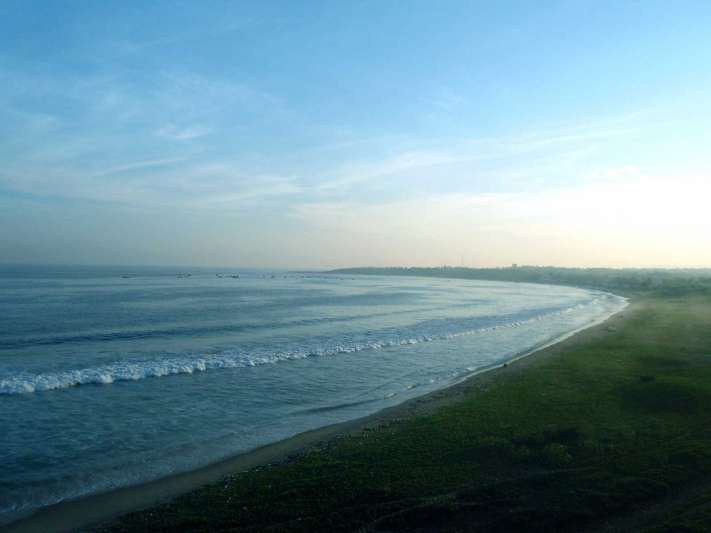

Islands Bay of Bengal
The Bay of Bengal is said to have once been dotted with islands, similar to Maldives or Hawaii. A study by the CSIR-National Institute of Oceanography (NIO) states that the chain of islands had once existed above sea level for 12 million years, today lie buried under the Bay of Bengal.
KS Krishna of CSIR-NIO Goa told Hindustan Times, “A series of natural processes that connected each other in the geological past caused the island chain to go first below sea level, then into the water, and finally below the sea floor. These islands are submerged under thick sediments discharged from the Ganges and Brahmaputra river systems.”
In the scenario that these islands had remained present, a sea voyage to Chennai would’ve meant passing these chain of islands before reaching the Andamans. These islands would also have protected the Indian mainland from tsunamis affecting the east coast of India. Krishna further stated, “Intensive tsunami waves, as witnessed in 2004, are being occasionally generated as a result of high-magnitude earthquakes near the region of Andaman and Sumatra islands, which travel towards the east coast of India. These island chains would have served as a geo-wall to the main land by pushing the waves back. The entire east coast would have been a safe zone from these hazardous waves, and that’s a big benefit indeed we have lost.”
Another advantage the country has lost is economic in nature. The areas surrounding these islands would’ve been potential Exclusive Economic Zones (EEZ) – a huge source for natural resources. By losing out on the islands, India has also lost out on opportunities to natural processes.
In 1982, a series of experiments carried out by researchers from various countries had unearthed the nature of the massive structure buried under three to four kilometre thick sediments. This has led to questioning the evolution of the structure with many hypotheses that failed to convince the scientific community.
It is over the past five years that NIO intensified its investigations and studied high quality geo-physical datasets that are generated by national and international petroleum and oil industries. The structures that lied buried now ran as a chain of mountains above the sea level in the Bay of Bengal 80 million years ago. They stood at an elevation ranging approximately between 500 and 1000 meters. They used to rest on a solid surface formed 120 million years ago beneath the Bay of Bengal.
Owing to their weight and thermal cooling, these massive mountains went below sea level 68 million years ago. Major river systems in India – including Cauvery, Krishna-Godavari and Mahanadi – carried the sediments from the continent that have been deposited at a very low rate in the Bay of Bengal. The process continued for 23 million years. “We have a situation where on one hand the mountains were subsiding; on the other hand, the sediments were getting deposited on the sides of these structures. So, at 23 million years, the deposited sediments covered the mountains
,” said M. Ismaiel of CSIR-NIO, Goa.When the Indian sub-continent collided with the Asian continent 40 million years ago, they led to the formation of the mighty Himalayas. Having reached maximum elevation, the Himalayas interacted with the atmosphere leading to the onset of monsoons in Asia. With the monsoons, the eroded sediments from these mountains were carried out to the Bay of Bengal.
“The deposited material was four times more than the sediments deposited by the peninsular rivers. As a result, three to four km of sediments sat on top of the mountains, causing them to subside further. This is how the mountains went below the sea floor, and today lies buried,” said K Srinivas of NIO Visakhapatnam.
The chain of islands stretched from Odisha to the middle of Bay of Bengal, Sri Lanka and close to the equatorial region. “We are confident that at least in the Bay of Bengal, these mountains may have survived as islands,” added Krishna. In a recent paper published in January, the team had investigated the origins of the mountains. “We found some evidence of volcanic activity, making it one of the most possible explanations of the evolution of this mountain,” he further stated.
The study was released in Current Science – published by the Current Science Association, in collaboration with the Indian Academy of Sciences.
This post was last modified on 06/04/2017 3:04 pm
In an incident that has left residents unnerved, a "naked thief" was caught on CCTV…
Kanchumurthi Eswar, a member of the Zonal Railway Users’ Consultative Committee (ZRUCC), has urged Divisional…
In a significant boost to Andhra Pradesh’s investment landscape, the 6th State Investment Promotion Board…
In a major boost to the hospitality landscape of Visakhapatnam, ITC Hotels has announced plans…
Brownies are one of the most popular desserts around the world. You can make this…
People look up to prodigies and geniuses for their uncanny intellect. While the appeal of…
Leave a Comment